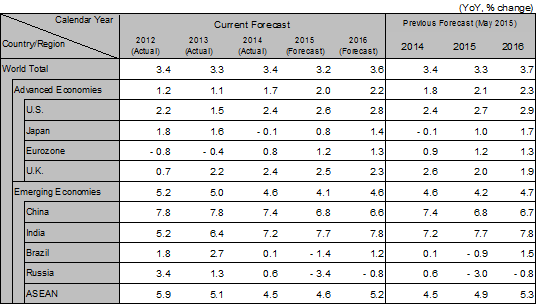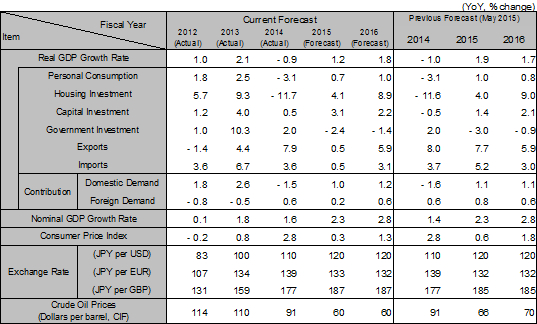Latest economic forecasts for Japan, the U.S., Europe, and China, etc
Triggered by the People's Bank of China's (PBC) devaluation of the Chinese Yuan by a total of approximately 4% over 3 days from August 11, global stock markets fell dramatically and the currencies of mainly resource-rich emerging countries have continued to fall. Behind this lies a lack of confidence in the policy of the Chinese government and PBC, which aims for a soft economic landing in a “new normal” by carrying out structural reform, and fears in the market that the actual situation is worse than that shown in official statistics.
China is striving for structural reform by shifting drivers of its economy from exports to domestic demand, from investment to consumption, and from the manufacturing industry to the service industry. However, this structural reform requires policy management as difficult as tightrope walking. Although domestic demand, consumption, and the service industry have been expanding since 2014, in excess of these expansions, the growth rate of exports, investment, and the manufacturing industry (production) is slowing down or decreasing. It is highly probable that the economic growth rate of China in the first half of 2015 will fall below 7% in the official statistics, with the actual status estimated at around 4% to 5%.
On the other hand, the recovery of the U.S. economy is steady since bottoming out. A decrease in exports to China constitutes a headwind for Japan and Europe, but due to steady exports to the U.S. and continuous quantitative easing, Japan and Europe are just managing to avoid immediate adverse effects. Resource-rich countries and Asia will continue to see economic slowdown.
Anticipating an end to the U.S. zero interest rate policy as the most important risk to the global economy is necessary. If the U.S. ends its zero interest rate policy amidst continuing market turmoil, there is a possibility of global stocks plunging as a result due to accelerating financial outflows from emerging countries and further devaluation of the Chinese Yuan.
The slowdown in the Chinese economy has caused a drop in resource prices such as iron ore, copper, and crude oil. Crude oil prices (WTI) had already softened since the Iran nuclear deal in July and briefly dipped below 40 dollars/barrel. Crude oil prices will recover to the 50 dollars/barrel level due to geopolitical risk in the Middle East. Low crude oil prices are a positive factor for economies in advanced countries.
In the U.S. economy, the labor market continues to improve, and a stable recovery driven by personal consumption continues. Although an end to the zero interest rate policy is expected to be shelved for September, the Federal Reserve is likely to raise interest rates by a quarter of 1% at its December policy meeting. Further increases in the policy interest rate will be slow and gradual. Household balance sheet adjustment is probably complete, and the housing market will continue to recover. Real GDP growth is forecast to increase slightly to 2.6% in 2015 and 2.8% in 2016, compared to 2.4% in 2014.
In the Eurozone economies, an exit from the euro by Greece has been avoided for the time being, and the recovery trend continues. With the euro depreciating against the U.S. dollar due to quantitative easing by the ECB, the German economy remains strong. For the economies of Spain and Italy recovering from the debt crisis, since the recovery follows a deep drop, the growth rate is commensurately high. Eurozone real GDP growth will continue to accelerate slightly to 1.2% in 2015 and 1.3% in 2016 compared to 0.8% in 2014. However, negotiations for debt restructuring will continue in Greece, and the possibility of a euro exit reigniting still remains.
Japan saw negative growth in the second quarter of 2015 (-1.6% annualized growth rate QoQ). A decrease in exports to China in electronic components, general machinery, and transportation machinery, etc. has been slowing down production, and a drop in the growth rate for FY2015 is unavoidable (Previous forecast: 1.9 -> Current forecast: 1.2%). Provided that the Chinese economy does not slow further in the second half of 2015, Japan is forecast to stay on the path to recovery, due to a boost in personal consumption caused by an increase in real wages, in turn caused by labor shortages and accelerating capital investment. However, the Bank of Japan will find achieving its FY2016 2% inflation target more difficult due to the drop in crude oil prices and the slower pace of recovery.

Note: The figures above are calendar-year. Accordingly, the figures for Japan are different from the fiscal-year based figures in the table below.
Source: IMF. Forecast by Hitachi Research Institute

Source: National Accounts, etc. Forecast by Hitachi Research Institute.